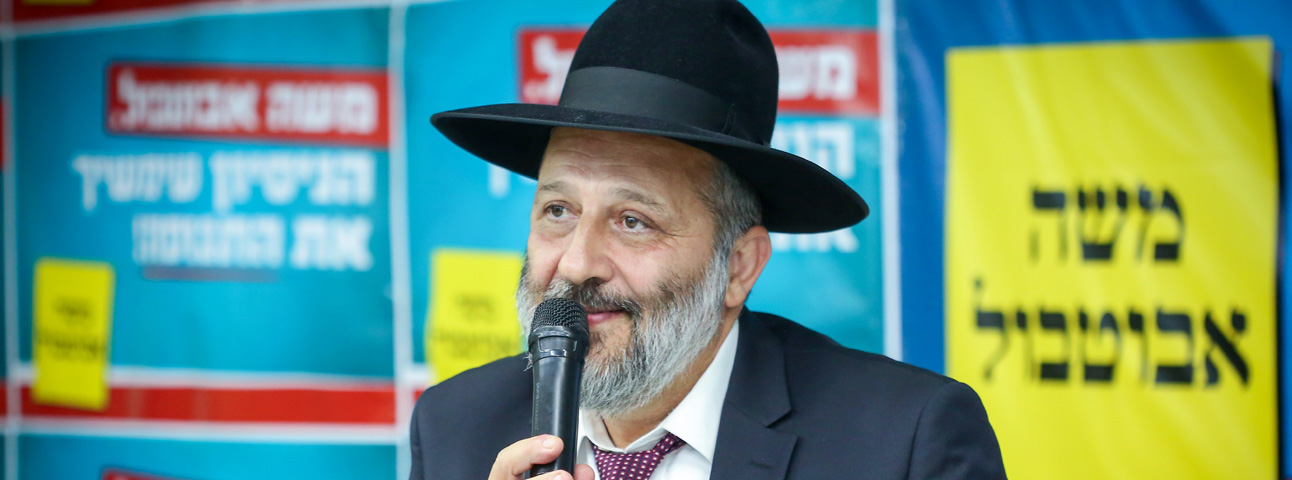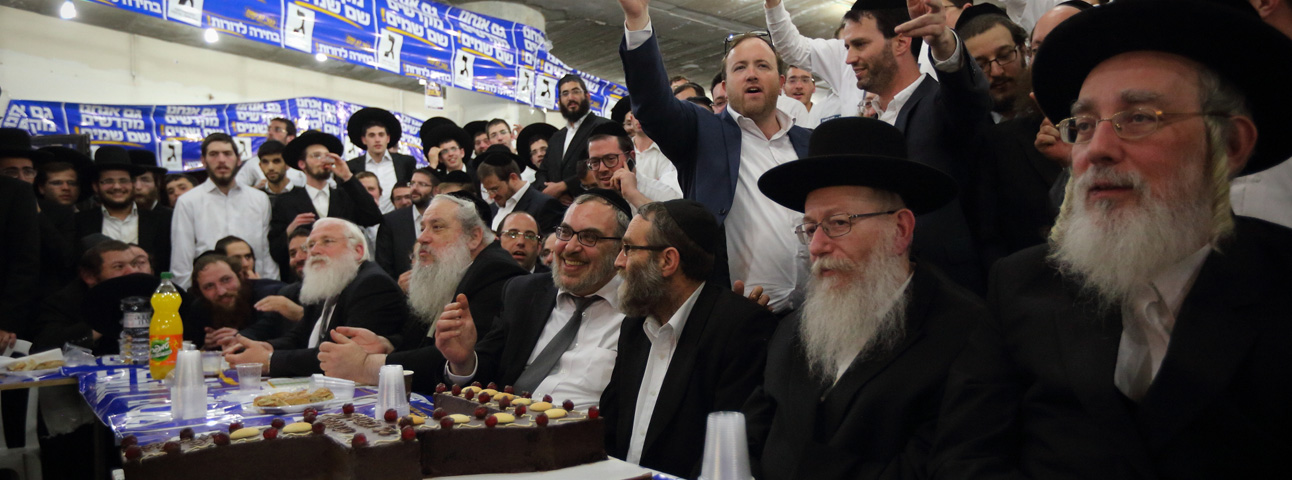Ultra-Orthodox Parties in Municipalities in Israel
Of all the political parties represented at a national level in Israel, the ultra-Orthodox parties are the most successful in local government. Their success is reflected not only in the number of ultra-Orthodox representatives on municipal councils, which is higher than of any other party , but also in the fact that they are to be found in a broad range of municipalities s, and not just in those with a large ultra-Orthodox population. Despite the changes being predicted for the upcoming local elections, in which the strength of the ultra-Orthodox parties may decline as a result of internal splits and the crisis in the Shas party, it would appear that the large national parties have much to learn from their ultra-Orthodox counterparts

Illustration | Flash 90
Thanks to Avital Friedman for her help with writing this article.Ultra-Orthodox parties enjoy very strong representation in local government, stronger even than in the Knesset. Shas (a Sephardic-ultra-Orthodox party) currently has the largest number of representatives in localities as compared with any other party in Israel (around 150); more than the Likud (around 135), Yisrael Beytenu (around 85), and Labor (around 80). United Torah Judaism—comprising two parties, Degel Hatorah and Agudat Yisrael—is also strongly represented, with some 75 representatives (State Comptroller Report , 2015), along with about 25 independent ultra-Orthodox representatives.
The number of party representatives does not reflect the size of the localities in which they are elected; for example, a representative in the Jerusalem municipality (who in order to be elected, must win a large number of votes) is counted just the same as a representative in the small local council of Metulla (which requires far fewer). This being the case, in this review I also relate to party funding, which is allocated according to the size of each locality and the number of seats won by each party. According to this measurement, Shas remains the largest party in local government, receiving NIS 20.2 million in the 2013 local elections. The Likud lags far behind with NIS 12.8 million, followed by Labor (NIS 11.9 million) and Yisrael Beytenu (NIS 10.8 million). United Torah Judaism received NIS 5.3 million in funding (State Comptroller, 2015).
Ultra-Orthodox parties enjoy very strong representation in local government, stronger even than in the Knesset. Shas (a Sephardic-ultra-Orthodox party) currently has the largest number of representatives in localities as compared with any other party in Israel (around 150); more than the Likud (around 135), Yisrael Beytenu (around 85), and Labor (around 80). United Torah Judaism—comprising two parties, Degel Hatorah and Agudat Yisrael—is also strongly represented, with some 75 representatives (State Comptroller Report , 2015), along with about 25 independent ultra-Orthodox representatives.
The number of party representatives does not reflect the size of the localities in which they are elected; for example, a representative in the Jerusalem municipality (who in order to be elected, must win a large number of votes) is counted just the same as a representative in the small local council of Metulla (which requires far fewer). This being the case, in this review I also relate to party funding, which is allocated according to the size of each locality and the number of seats won by each party. According to this measurement, Shas remains the largest party in local government, receiving NIS 20.2 million in the 2013 local elections. The Likud lags far behind with NIS 12.8 million, followed by Labor (NIS 11.9 million) and Yisrael Beytenu (NIS 10.8 million). United Torah Judaism received NIS 5.3 million in funding (State Comptroller, 2015).

Illustration | Flash 90
A comparison of the results of the January 2013 national election with those of the October 2013 local elections, among a representative sample of cities in which Shas and United Torah Judaism fielded candidates, shows that United Torah Judaism did better locally than in the Knesset elections. In the nine cities studied, the overall share of the vote in the local elections gained by United Torah Judaism was 14.7%, compared with 11.7% of the vote in those cities in the national elections. Similarly, support for Shas was stronger in the local elections than in the national elections, albeit with a smaller gap between the two. In 11 cities studied, Shas garnered 14.1% of the vote in local elections, compared with 13.6% of the vote in those cities in the national elections.
The significant representation of the ultra-Orthodox in local government can be attributed to two main factors. The first--the high voter turnout among the ultra-Orthodox population, a minority group fighting for its status in Israeli society (Atmor, 2013; Blander, 2008). High ultra-Orthodox voter turnout is seen in Knesset elections as well, but because of the relatively low voter turnout among the general population in local elections, the differences between the two sectors are more pronounced on the local level.
The second factor underlying the strong representation of ultra-Orthodox parties in local government is the fact that the group interests of the ultra-Orthodox population are even more prominent in local elections than in national elections (Ben-Bassat, Dahan, and Klar, 2013). Thus, despite the decline and near-extinction of the main national parties in local elections, the ultra-Orthodox population is unwavering in its support for ultra-Orthodox parties, which therefore maintain a high level of representation.
The changing patterns in local election results reflect demographic and geographic changes in the distribution of the ultra-Orthodox population throughout Israel. In the first years of the state, there was not a single representative of Agudat Yisrael elected to serve as head of a municipal council. This changed in 1983, when the party’s candidate was elected mayor of Bnei Brak. Especially noteworthy is the case of Jerusalem, in which the growth in ultra-Orthodox representation on the city council reflects the demographic changes in the city. Until 1978, around one-sixth of the council members were ultra-Orthodox representatives. The entry of Shas to local politics in 1983 increased ultra-Orthodox representation during the 1980s and 1990s to between one-quarter and one-third of the council. Following the continued growth of the ultra-Orthodox population in Jerusalem, from 2003 onward ultra-Orthodox representation stabilized at between 42% (2008) and 45% (2003 and 2013) of council members.
The Ultra-Orthodox Parties: Voting Patterns, Mergers, and Splits
The distribution in the representation of Shas compared with that of the United Torah Judaism party reflects the difference between the characteristics of these parties. Shas appeals to a broad audience, the bulk of which is traditional-Orthodox, and as a result-- has elected representatives in localities throughout the country. The 2013 local elections brought significant Shas representation even in non-religious cities, including Eilat, Ashkelon, Beer Sheva, Bat Yam, Holon, and Netanya. By contrast, United Torah Judaism appeals only to explicitly ultra-Orthodox voters, and as a result-- is represented only in ultra-Orthodox localities or in those with a strong ultra-Orthodox presence.
Local elections also reveal the differences between the center and the periphery within the ultra-Orthodox sector. In localities with a large ultra-Orthodox population, the ultra-Orthodox parties will generally run separately from one another, as is the case in Jerusalem, Ashdod, Beit Shemesh, and most of the ultra-Orthodox localities. In Jerusalem, the ultra-Orthodox lists in the 2013 elections weren’t fully able to unite behind the candidacy of Moshe Leon, and this split paved the way to Nir Barkat’s victory. However, in the ultra-Orthodox periphery, at a geographic distance from the large concentrations of ultra-Orthodox residents, there tends to be a merger into a single list—of Shas together with United Torah Judaism or one of its component parties (Agudat Yisrael and Degel Hatorah).
The Elections in Ultra-Orthodox Cities
Ultra-Orthodox localities are a fascinating case-study of the tension between attempts to reach top-down rabbinical-political agreements and the huge competition between ultra-Orthodox parties and streams in each city. In advance of each election campaign, political efforts are made to reach national and local agreements between Shas, Degel Hatorah, and Agudat Yisrael, but in most cases these are not successful. Although there are some unusual exceptions, elections are held in all ultra-Orthodox localities every five years, as required by law.
The election of city council heads presents a more complex picture, and in many cases the national political leadership has been able to reach agreements that prevent open elections. In Bnei Brak, Israel’s largest ultra-Orthodox city, there have been no mayoral elections since 1998, due to a long-term rotation agreement between Agudat Yisrael and Degel Hatorah. In Jerusalem, agreements have been reached in the past for across-the-board ultra-Orthodox support for a Degel Hatorah candidate (in 2003), an Agudat Yisrael candidate (2008), and a secular candidate (2013).
The 2018 Local Elections
The upcoming local elections present major challenges for the ultra-Orthodox parties. These elections follow the dramatic fall of Shas in the 2015 Knesset elections, from eleven to seven seats, and the forecast is for additional decline at a national level. The main drop-off in support for Shas has come from outlying localities in the country’s periphery, and among populations that are not explicitly ultra-Orthodox (Ettinger and Leon, 2018). As a result, in the upcoming elections we may see a drop in the number of Shas representatives in local government. There may also be a decline in the number of ultra-Orthodox representatives overall, due to the fact that Election Day has been declared a non-working day, which may increase the turnout among voters who are not ultra-Orthodox. On the other hand, an increase in the number of ultra-Orthodox candidates elected can be expected in places where there has been a significant increase in the relative size of the ultra-Orthodox population, such as Arad, Kiryat Gat, and Ofakim in the south; Safed, Afula, and Tiberias in the north; and Givat Ze’ev in Judea and Samaria.
However, the main drama is expected to unfold in Jerusalem. The continued “ultra-Orthodoxification” of the city may well bring about the election of an ultra-Orthodox mayor--Yossi Deutsch, if all the ultra-Orthodox factions unite to support his candidacy—in itself, a very challenging task. If voter turnout remains low among the secular and national religious publics and if Shas is able to maintain its standing in the city council, then the ultra-Orthodox parties may—for the first time-- win a majority in the city council.
Generally speaking, the strength of opposition parties is expected to rise, and internal struggles are likely to intensify. At the time of this writing, elections are due to be held in all the ultra-Orthodox localities, and in some---the elections will be a fierce battle. Local opposition parties that competed in 2013 in Beitar Illit, Elad, and Kiryat Ye’arim will compete once again in 2018, and may well be joined by Eli Yishai’s Yachad party, which is expected to gain representatives in Jerusalem, Bnei Brak, Elad, and Ashdod. There is also a significant new phenomenon of candidates coming from the “modern” (employed), ultra-Orthodox community. In Jerusalem, two of these candidates are running for parties that are not ultra-Orthodox, having learned from the failure of running independently in the 2013 elections. Time will tell whether this phenomenon reflects a deeper trend within the modern ultra-Orthodox stream regarding partnership with populations that are not ultra-Orthodox.
References
Atmor, Nir. 2013. Participation in Local Elections: Findings and Conclusions. Parliament, 77. Israel Democracy Index website [Hebrew].
Ben-Bassat, Avi, Momi Dahan, and Esteban Klor. 2013. Representativeness and Efficiency in Local Authorities. Jerusalem: Israel Democracy Institute.
Blander, Dana. 2008. Is There a Link Between the 2008 Local Elections and the 2009 National Elections? Israel Democracy Index website [Hebrew].
Ettinger, Yair, and Nissim Leon. 2018. A Flock with No Shepherd: Shas and the Mizrachi Ultra-Orthodox Leadership After Rabbi Ovadia Yosef. Jerusalem: Israel Democracy Institute [Hebrew].
State Comptroller. 2015. Report on the Results of Audit of Expenses of Parties that Participated in Local Elections in October 2013. Jerusalem: State Comptroller’s Office [Hebrew].
